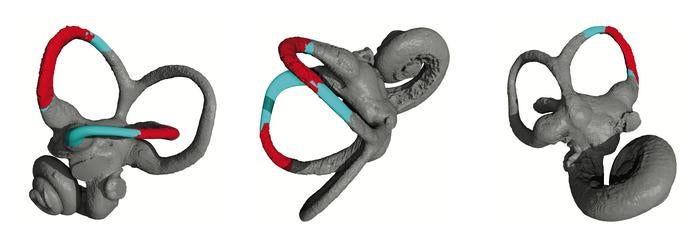Tracing how some primates went from getting around on all fours to walking around on two legs has been difficult. The fossil record hasn’t always presented a clear evolutionary history of bipedalism. These days, our species primarily walks upright on two legs, but primates can also climb up trees using arms and legs to propel the body. Some primates like great apes typically walk using all four limbs and smaller monkeys gracefully swing among tree branches. Scientists are now beginning to see more clearly how humans developed our bipedal walking ability, by studying the inner ears of the extinct primate Lufengpithecus—likely, an evolutionary stepping stone.
[Related: Our tree-climbing ancestors evolved our abilities to throw far and reach high.]
A team of scientists used three-dimensional CT-scans of a 6-million-year-old fossilized Lufengpithecus skull’s bony inner ear and found a structure that looks similar to some of today’s bipedal mammals. This inner ear area likely played a role in bipedal evolution. The findings are described in a study published January 29 in the journal The Innovation.
Meet Lufengpithecus
Lufengpithecus lived in East Asia during the Miocene Era, about 23 million to five million years ago. The land-dwelling animals at this time were starting to look more like the animals we see today, but some of their earlier and intermediate forms like Lufengpithecus were still living.
“It would have been about the size of a chimpanzee. We don’t have too many clues to this, but we can be pretty sure it was primarily specializing in fruit,” study co-author and New York University biological anthropologist Terry Harrision tells PopSci. “It did seem to have relatively long arms and it would have been quite fragile moving around the trees. Most of its time would have been spent in the trees.”
The team examined skulls that were first discovered in China’s Yunnan Province in the early 1980s. Unfortunately, the skulls have become damaged over time and previous work on them revealed that the crucial and delicate semicircular canals in the inner ear were not well preserved.
“The semicircular canals, located in the skull between our brains and the external ear, are critical to providing our sense of balance and position when we move, and they provide a fundamental component of our locomotion that most people are probably unaware of,” Yinan Zhang, a study co-author and Institute of Vertebrate Paleontology and Paleoanthropology of the Chinese Academy of Sciences (IVPP) PhD student, said in a statement. “The size and shape of the semicircular canals correlate with how mammals, including apes and humans, move around their environment. Using modern imaging technologies, we were able to visualize the internal structure of fossil skulls and study the anatomical details of the semicircular canals to reveal how extinct mammals moved.”
Recreating a six-million-year old inner ear
To get a more accurate look inside Lufengpithecus’ inner ears, the team needed to recreate the damaged semicircular canals using data from the fossil record. The team used three-dimensional scans to virtually recreate the inner ear’s bony canals. They then compared the scans to living and fossil apes and humans from Africa, Europe, and Asia.
[Related: Foraging in trees might have pushed human ancestors to walk on two feet.]
“Our analyses show that early apes shared a locomotor repertoire that was ancestral to human bipedalism,” study co-author and IVPP paleoanthropologist Xijun Ni, said in a statement. “It appears that the inner ear provides a unique record of the evolutionary history of ape locomotion that offers an invaluable alternative to the study of the postcranial skeleton.”

From this comparison, the team believes that three steps led to the evolution of human bipedalism. Apes first moved in the trees in a style that is similar to how today’s gibbons swing through trees. The last common ancestor of both apes and humans used a combination of climbing, clambering, walking on four limbs while on the ground, and using only two limbs in trees to get around. It was from this mix of motion that bipedalism eventually became dominant in humans. It’s possible that once our species got a solid grasp of walking on two legs, more fine motor skills that are related to the inner ear like balance could be refined over time.
“Even though humans generated bipedalism during their evolutionary history, we did come from a group of very unusual primates that developed unique ways of moving around their environment,” says Harrison. “So we are an oddity.”
Incredible ape diversity
As a species that is in the middle of an evolutionary tree, Lufengpithecus gives scientists a window into understanding how ape diversity originated over 20 million years ago. The team also believes that climate changes may have been an important environmental catalyst of how apes and their ways of movement evolved. Ice sheets began to form in the Northern Hemisphere and temperatures began to cool about 3.2 million years ago. These environmental changes corresponds to an uptick of changes in the bony labyrinth of the inner ear.
Future research is needed to determine exactly why evolving this way of walking around was particularly helpful as the ice sheets in the Northern Hemisphere were growing and why ape diversity began to decrease worldwide.
“The modern [living] apes are just a small sampling of the incredible diversity that we’ve had in the past. We wouldn’t have known about this incredible diversity haven’t had if it hadn’t been for the fossil record,” says Harrison. “It’s confusing, and it won’t be figured out in my lifetime, but the fact is, we’re getting a lot closer to really beginning to understand it.”





